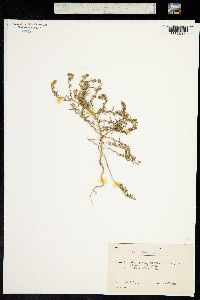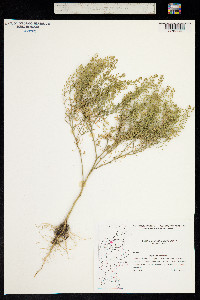Lepidium ruderale
|
|
|
|
Family: Brassicaceae
Roadside Pepperwort
|
Annuals or biennials; (fetid); puberulent (trichomes cylind-rical). Stems simple from base, erect ascending, branched (several) distally, (0.5-)1-3.5 (-5.5) dm. Basal leaves rosulate; petiole 1-3.2(-5.3) cm; blade (1- or) 2- or 3-pinnatisect (lobes oblong), (1.5-)3-5(-7.2) cm, margins (of lobes) usually entire, rarely dentate. Cauline leaves sessile; blade linear, (0.4-)1-2(-3) cm × 0.5-2.5(-3.5) mm, base cuneate, not auriculate, margins entire. Racemes considerably elongated in fruit; rachis puberulent, trichomes straight, cylindrical. Fruiting pedicels divaricate to horizontal, straight, (terete), (1.5-)2-4(-5) × 0.1-0.15 mm, puberulent. Flowers: sepals oblong, 0.5-0.9(-1) × 0.2-0.4 mm; petals (absent or rudimentary), white, linear, 0.2-0.5 × 0.1 mm, claw absent; stamens 2, median; filaments 0.7-0.8 mm; anthers 0.1-0.2 mm. Fruits elliptic, (1.5-)1.8-2.5(-3) × 1.5-2(-2.3) mm, apically winged, apical notch 0.1-0.2 mm deep; valves thin, smooth, not veined, glabrous; style obsolete or to 0.1 mm, included in apical notch. Seeds oblong to ovate-oblong, 1-1.5 × 0.6-0.8 mm. 2n = 16, 32. Flowering Apr-Jul. Fields, pastures, waste places, roadsides, gardens; 0-300 m; introduced; Alta., B.C., Man., N.B., Nfld. and Labr. (Nfld.), N.S., Ont., P.E.I., Que., Sask.; Ala., Ark., Calif., Del., Fla., Ind., La., Maine, Md., Mass., Mich., N.H., N.J., N.Mex., N.Y., N.C., Ohio, Oreg., Pa., R.I., Tenn., Tex.; Eurasia; introduced also in South America, Australia. Annual or biennial herb 20 cm - 0.5 m tall Stem: branched above, minutely hairy. Flowers: in branched clusters (raceme). Petals four, greenish. Stamens two. Fruit: a small pod, six to ten per centimeter, ascending, 2 - 3 mm long, three-fourths as wide, egg-shaped to elliptic, flattened, tips notched, wingless. Seeds wingless. Odor: foul. Basal leaves: in a loose rosette, twice pinnately divided, long-stalked, minutely hairy. Stem leaves: alternate, pinnately divided (lower leaves) or linear (upper leaves), not clasping, less than 1 cm wide, tips rounded, sometimes toothed, minutely hairy. Similar species: Lepidium latifolium is similar but has lance-shaped to narrowly egg-shaped leaves that are sometimes over 1 cm wide. Lepidium densiflorum differs by having basal leaves which are coarsely toothed or once pinnately divided, but not twice pinnately divided. Lepidium virginicum differs by having flower petals equal to or nearly twice as long as the sepals. Also, none of the aforementioned Lepidium species have a distinctively foul odor like L. ruderale does. Flowering: late April to early June Habitat and ecology: Introduced from Europe. A weed found along railroads and in waste places. Also look for it in disturbed areas such as fairgrounds, vacant lots, and roadsides. Occurence in the Chicago region: non-native Etymology: Lepidium comes from the Greek word lepis, meaning scale, which refers to the shape of the fruit. Ruderale means rough. Author: The Morton Arboretum Foetid, minutely hairy annual or biennial, 2-5 dm; basal lvs commonly bipinnately lobed; lower cauline lvs usually pinnatifid, the upper entire or dentate, rounded or obtuse at the tip; stamens 2; mature racemes loose, with 6-10 frs per cm; fr ovate to elliptic, generally broadest near or below the middle, 2-3 mm, three-fourths as wide, wingless; stigma included in the notch; seeds wingless; 2n=16. Native of Europe, intr. in waste places here and there in our range. Gleason, Henry A. & Cronquist, Arthur J. 1991. Manual of vascular plants of northeastern United States and adjacent Canada. lxxv + 910 pp. ©The New York Botanical Garden. All rights reserved. Used by permission. From Flora of Indiana (1940) by Charles C. Deam Indiana Coefficient of Conservatism: C = null, non-native Wetland Indicator Status: N/A |































































